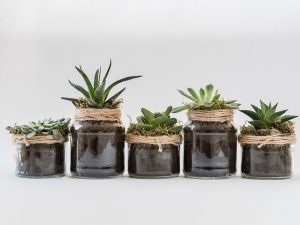All You Need to Know About Succulents
When it comes to home decor, everyone talks about bringing the outdoors in – especially plants and greenery. But, if you don’t have a “green thumb,” – it might seem a little daunting – and expensive – to bring in plants that you might end up killing.
And yes, you could bring in artificial plants – after all, there are some very realistic-looking ones out there.
But you don’t have to. There are some plants available that can handle some neglect. Air plants are always an option. Cacti are good, too. And, of course, there are succulents.
Succulents have become extremely popular in recent years. With all of their different varieties – it’s easy to see why.
If you’re thinking about picking up some succulents for your place, here’s a little information to get you started.

What are succulents?
According to the website Succulent Plant Care, succulents are defined as, a collection of plants that have water storage tissues. Succulent plants are drought-resistant plants. They have adapted to survive very dry, arid conditions. These plants typically store water in their leaves, their stems, or their roots.
You will find that succulents have leaves that are very plump and rather thick as a means of conserving water.
How do you care for succulents?
Do you know the four basics when it comes to plant care? They are light, water, temperature, and soil. These same four basics apply to succulents, too.
- Light – If you’ll be bringing some succulents home, keep in mind that they will need between 2-4 hours of sunlight per day. They like direct sunlight – so think about putting them near a window or on a windowsill when possible.
- Water – You want to be sure not to overwater your succulents. Wait until the soil is dry before adding any water – as you don’t want the roots to rot from having too much water. Succulents are used to dry weather, and you might find that watering once per week is all they need.
- Temperature – Most succulents can handle temperature fluctuations – as long as you don’t go below freezing. If you have a really delicate succulent, it may not like extreme heat (above 95 degrees or so) – but it’s doubtful you’ll ever have temperatures that high in your home.
- Soil – You want soil that provides adequate drainage of water. Look for soil designed for cacti, and make sure your pots have drainage holes.
What are some popular types of succulents?
There are so many varieties of succulents available, but here are a few of the popular ones you might bring home!
- Burro’s Tail (Burrito) – tends to produce long stems that look like tails
- Cobweb Houseleek – these tend to look like little, fluffy rosettes
- Hens and Chicks – this is another one that tends to look like little rosettes, and the “babies” it produces are the chicks
- Jade Plant – very popular for indoor growing and can grow to be quite tall
- Jelly Bean – this cute little succulent will turn red when exposed to the sun in the summer – which is how it gets its name
- Mexican Firecracker – this one has lots and lots of leaves covered with fuzzy “hair” – and with enough sunlight, it can take on a reddish color
- Moonstones Plant – a great choice for beginners – it can have leaves that range from green to pink to gray
- Mother of Pearl – they look like rosettes and can be pink, purple, green, gray, yellow, or blue
- Red Pagoda/Shark Tooth – the stacked leaves create a unique looking succulent
Succulents are a great plant for your home – even if you don’t have a green thumb. Head to your local nursery and pick up a few for your place!








